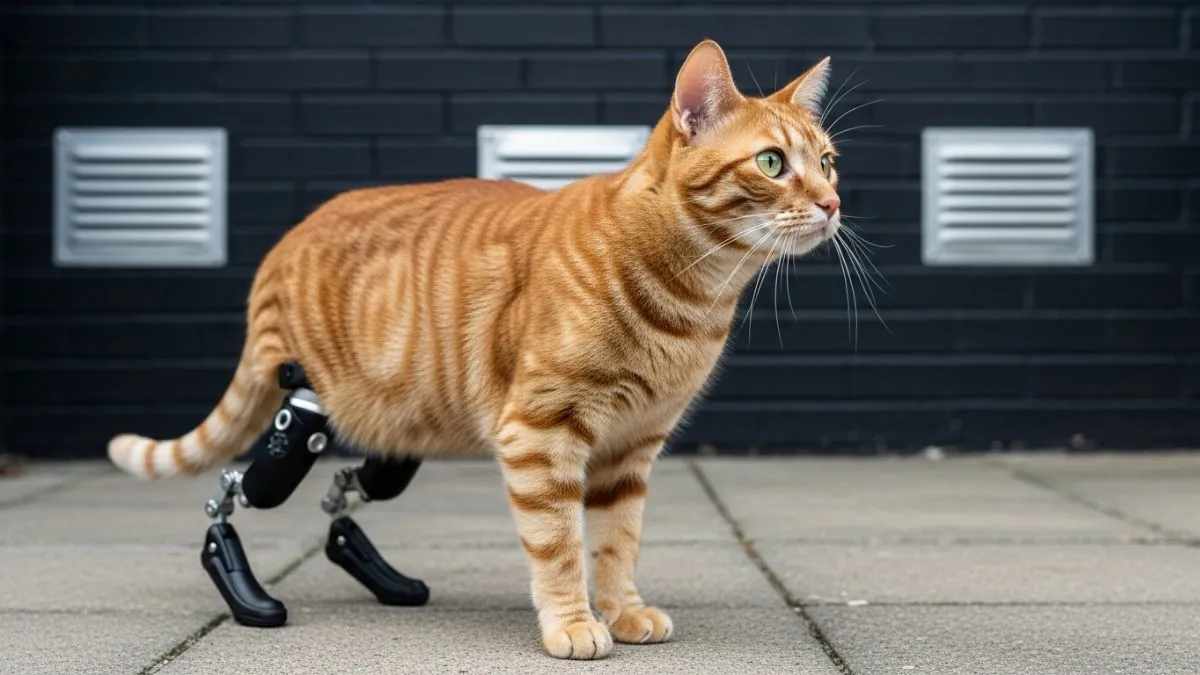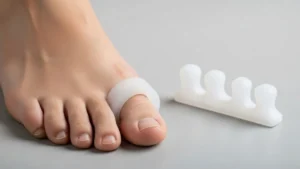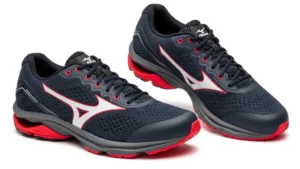
Yes, a cat can walk with a prosthetic leg if it’s properly fitted and supported during recovery. Most cats begin adjusting within a few weeks. Comfort, weight balance, and rehab are key factors. Once they build confidence, many return to walking, climbing, and even playing like before.
Cats aren’t built the same as dogs. Their smaller size and independent nature make mobility challenges a bit trickier. But prosthetic legs are designed with that in mind. The goal is to restore balance and movement by working with the cat’s natural posture and weight distribution.
Most prosthetics sit snug on the remaining limb or stump. They’re molded to match the cat’s body, often using light carbon fiber or silicone-based materials. The lighter the design, the easier it is for the cat to accept and use it.
Why Cats Might Need a Prosthetic
- Severe injury or trauma
- Amputation due to infection or cancer
- Congenital limb deformities
- Post-surgery complications
Some cats lose a limb from accidents—car strikes, machinery, or falls. Others are born with partial limbs. In both cases, prosthetics help fill the gap and bring back movement that’s otherwise lost.
Real Success Story
One Maine Coon named Jasper lost part of his hind leg in a lawnmower accident. His vet fitted him with a partial-limb prosthetic after two months of healing. At first, Jasper hesitated. But after 3 weeks, he was climbing furniture again. By week 6, he was chasing toys across the living room like nothing had changed.
What Vets Say
Most vets agree:
if the remaining limb is healthy and the prosthetic fits well, success is likely. Some cats adapt in days. Others take a few weeks. But once they realize the limb helps, not hurts, progress speeds up.
Prosthetics don’t just support movement—they improve quality of life. Without one, many cats overuse their other limbs, leading to joint strain. A prosthetic helps even things out and reduce that long-term damage.
You Might Also Like: THERUNNINGPOST
What Types of Prosthetic Legs Are Made for Cats?
Cats can be fitted with full limb replacements, partial limb prosthetics, or supportive devices like splints and braces. The type used depends on how much of the leg remains, the cat’s age, weight, and overall health. Custom fitting ensures comfort, and the right choice improves balance, mobility, and daily life.
Full Limb Replacements
When a cat loses an entire leg, a full prosthetic takes its place. These are custom-molded using scans or casts to match the cat’s shape. The design wraps comfortably around the shoulder or hip area and mimics the motion of a real leg.
Materials used are soft but durable—usually silicone-lined sockets paired with carbon or lightweight polymers. This balance gives support without weighing the cat down.
Full replacements are more common in larger breeds like Maine Coons or Savannah cats. Smaller cats sometimes find them bulky unless tailored extremely well.
Partial Limb Prosthetics
If part of the leg remains, partial prosthetics work best. These attach below the knee or elbow and offer better control and comfort. Cats find it easier to balance since part of their original limb helps guide movement.
Partial prosthetics are more stable and usually require less training. They also cost less than full replacements and have fewer fit-related issues. These are the most common type used in domestic cats, especially after amputations due to accidents or tumors.
Supportive Devices vs True Prosthetics
Not every mobility aid is a prosthetic. Splints and braces support injured or healing limbs but don’t replace a missing part.
- Splints are stiff supports used short-term for fractures or tendon injuries.
- Braces help with joint support, often used for arthritis or ligament tears.
- Prosthetics actually replace a lost part of the body.
A cat with arthritis might get a brace. One with a missing paw needs a prosthetic. The decision depends on the injury, pain level, and long-term outlook. Vets typically choose the least invasive method first. If a splint or brace can help, they go that route before moving to prosthetics.
According to User experience About Prosthetic Leg
This data about prosthetic leg user experiences has been collected from a few sources, specifically from those who have already undergone the process, and it comes from forums like Reddit and Quora:
Oscar (Jersey)
Oscar survived a terrible farm injury and was the first cat fitted with implants grafted into his bones. He later walked with custom prosthetic feet and even holds Guinness records for his pioneering surgery.
Layla’s Rescue (Stray Cat)
A rescued stray cat missing one hind leg received a partial prosthetic. Within two weeks of receiving it, the cat regained nearly balanced gait and used all three legs evenly while moving.
Minnie (unspecified owner)
A tabby fitted with an external prosthetic foot regained her bounce. She reportedly resumed normal behaviors like jumping and kneading after initial hesitation.
Rescue cat case
A rescue tabby fitted with a partial prosthetic regained balanced walking in two weeks. Owners noted decreased overuse injuries in other limbs.
Bionic leg anecdote
A 3D-printed external prosthetic helped a small cat walk again within days. Family reported increased playfulness and less reliance on bedding.
How Do Vets Fit Prosthetics for Cats?
Vets fit prosthetics by evaluating the injury, creating a custom mold, and testing the fit over time. It starts with scans, followed by detailed measurements, and ends with adjustments based on how the cat walks. The process takes a few weeks and requires close monitoring to prevent discomfort or injury.
Initial Evaluation and Imaging
The first step is understanding the damage. Vets use X-rays and CT scans to assess bones, joints, and any remaining tissue. These images help guide the design, especially if part of the limb is still there.
They also check how the cat moves—how it shifts weight, whether it favors one side, or avoids pressure. All of this affects how the prosthetic will be shaped and where support is needed most. Cats with strong shoulders or hips usually adapt faster. But weak joints or excess weight may need extra stabilization.
Creating a Custom Mold
Once the injury is assessed, the vet creates a mold. This can be done with 3D scanning or old-school plaster casting. The goal is to get every angle and curve right—because even a small mistake can cause rubbing or pain.
Measurements include:
- Length of the remaining limb
- Width and shape of the socket area
- Walking angle and balance points
If using 3D printing, the digital file goes straight to the lab. Manual molds take a bit longer. Either way, the wait is usually 2 to 3 weeks for the final piece to arrive. Some advanced clinics use motion capture to track how the cat walks naturally, then build the prosthetic to mimic that rhythm.
Test Fit and Adjustments
Fitting day isn’t the finish line—it’s a checkpoint. Vets start by sliding the prosthetic on gently and watching how the cat reacts. Most cats need help learning how to walk with it.
It’s normal to go through multiple adjustments. Some cats need a tighter fit. Others need softer padding. Owners should watch for:
- Redness or sores near the socket
- Limping or paw chewing
- Refusing to walk
If any of these show up, the prosthetic needs adjusting. A good fit should feel like an extension of the body, not a foreign object.
How Long Does It Take for a Cat to Walk Again?
Most cats start using their prosthetic leg within 2–4 weeks after fitting. Healing speed, training, and personality all play a role. Some take a bit longer, especially older cats. With daily support and vet check-ins, many return to basic walking routines within a month.
Post-op Healing Time
Before anything gets attached, the surgery site needs to heal. That usually takes 10–14 days if there are no complications. During this time, movement is limited. The focus is on keeping the area clean, dry, and free of pressure.
Pain meds help, but rest is key. No running, jumping, or rough play. Once stitches are out and the vet gives the green light, the fitting begins.
First Steps: How to Support Walking at Home
- When the prosthetic goes on, don’t expect perfect strides. Most cats act like they’ve got a shoe stuck to their paw.
- Start slow. Keep the floor clear. Use rugs for grip. Gently guide your cat with treats, toys, or your voice.
- Limit sessions to a few minutes, 2–3 times daily. Gradually increase as they get more confident.
Importance of Consistency and Patience
Daily use matters:
- The more the cat wears the prosthetic, the faster they learn. But don’t force it.
- If they’re scared or frustrated, back off. Stick to a routine.
- Same times, same area, same cues. Cats love patterns—and routines help rebuild muscle memory.
- Be patient. One day might feel like a breakthrough. The next might feel like a step backward. That’s normal.
Signs of Progress vs Red Flags
Progress signs:
- Using the leg during play or eating
- Standing with even weight on all limbs
- Less hesitation when walking
Red flags:
- Consistent limping
- Refusing to walk at all
- Biting or chewing the prosthetic
- Visible wounds or skin irritation
If anything looks off, call the vet. The sooner it’s adjusted, the better.
What Does a Cat’s Rehabilitation Look Like After Getting a Prosthetic?
Rehabilitation includes daily exercises, behavior monitoring, and regular vet checks. At home, gentle physical therapy builds strength. Cats may act moody or distant at first, but progress happens with time and routine. Watch for warning signs like limping or skin issues—those mean the prosthetic needs adjusting.
- Bringing a cat back to full mobility doesn’t stop with the prosthetic. It starts there.
- Rehab is where the real work happens—and it’s mostly on your turf, not the vet’s.
Physical Therapy at Home
You don’t need fancy equipment. Just time and soft hands.
- Start with range-of-motion exercises. Gently move the limb up, down, forward, and back. This keeps the joint loose and helps your cat get used to moving again.
- Massage and light stretching ease muscle tightness. Focus on areas near the prosthetic and on the opposite leg. Overcompensation can cause stiffness elsewhere.
- Ask your vet about pet physiotherapy routines. Some may suggest balance pads, wobble boards, or soft ramps. Sessions should be short and calm—think five to ten minutes, twice a day.
Behavior Changes to Expect
Cats aren’t known for hiding their moods. So don’t be surprised if yours acts off.
You might see:
- Hiding more than usual
- Ignoring the prosthetic
- Avoiding eye contact or physical touch
This isn’t defiance—it’s confusion. Your cat doesn’t know why their leg feels different.
Encouragement beats pressure.
- Toss a treat near the ramp.
- Wiggle a feather toy a few feet away.
- Let your cat come to the challenge, not the other way around. And praise matters.
- Use a soft voice.
- Celebrate the small wins—like one confident step or standing still without wobbling.
When to Call the Vet
Even if everything looks fine, problems can show up quietly. That’s why daily checks are important.
Call your vet if:
- The cat limps more after a week of use
- Skin near the prosthetic looks red, swollen, or raw
- Your cat constantly chews or licks the area
- The prosthetic looks loose, twisted, or wobbly
Pain, pressure sores, and misalignment are all fixable—but only if caught early.
How Much Do Cat Prosthetic Legs Cost?
Cat prosthetic legs usually cost between $1,000 and $2,500. The price depends on how complex the design is, what materials are used, and how many vet visits are needed. While insurance rarely covers it, some nonprofit groups offer financial help to make treatment more affordable.
Breakdown of Typical Costs
Here’s a basic cost structure for one prosthetic leg:
- Initial vet consult: $100–$200
- Imaging (X-rays, scans): $150–$400
- Mold and design: $500–$1,000
- Fabrication and fitting: $600–$1,200
- Follow-up adjustments: $100–$300
Add it up, and you’re looking at $1,000 to $2,500 depending on the clinic and complexity. Full limb replacements cost more than partial prosthetics. Extra fittings or materials like carbon fiber also bump the price.
Insurance Coverage or Lack Thereof
Most pet insurance plans don’t cover prosthetics. They may help with diagnostics or surgery but stop short of funding the actual device. Always check your plan before assuming.
If you’re shopping for insurance now, look for companies that include orthopedic care under accident or injury plans. It won’t cover everything—but it can knock off a few hundred dollars.
Financial Assistance Programs or Nonprofit Help
If the cost feels out of reach, you’ve got options. Some nonprofit organizations help pet owners cover part or all of the cost.
Examples include:
- Handicapped Pets Foundation
- The Pet Fund
- RedRover Relief
Local vet schools also run donation-supported programs. Some custom prosthetic makers offer payment plans or sliding scale fees, especially for rescue animals or low-income owners.
Where Can You Get a Prosthetic Leg for a Cat?
Cat prosthetic legs can be sourced through specialized veterinary orthopedic clinics or ordered from trusted online providers. While in-person fittings offer precise results, some reputable online companies also produce custom prosthetics—if sizing is accurate. Your general vet can help guide you to the right option.
Veterinary Orthopedic Clinics
These clinics specialize in advanced mobility solutions like prosthetics, braces, and limb-saving surgeries. Here’s how to find one:
- Ask your regular vet for a referral. Most general practitioners don’t offer prosthetics but know who does.
- Search online for veterinary orthopedic centers in your region.
- University vet hospitals or animal rehab centers often have partnerships with prosthetics designers.
Pros:
Custom in-person fitting, real-time adjustments, professional oversight
Cons:
May be more expensive and less accessible in rural areas
Online Pet Prosthetic Providers
Ordering a prosthetic online is now a viable option—but it requires exact measurements, often taken at home with your vet’s help.
Pros:
- More affordable
- Convenient ordering
- Global access to custom designs
Cons:
- Risk of poor fit
- No in-person adjustments
- Requires precise limb imaging or molds
Top 3 Reputable Providers:
- Bionic Pets: Known for custom-fit animal prosthetics and TV-featured work
- OrthoPets: Trusted by veterinary hospitals and teaching institutions
- Animal Ortho Care: Offers 3D-printed and foam-cast options with detailed sizing guides
Are Prosthetic Legs Safe for Cats?
Yes, prosthetic legs are safe for cats when properly fitted, regularly monitored, and maintained. Most complications arise from poor fit, lack of hygiene, or delayed adjustments. Always follow your vet’s guidance, clean the device often, and inspect for irritation or wear to keep your cat comfortable and mobile.
Common Risks and How to Prevent Them
Prosthetics are generally well-tolerated, but there are a few common issues to watch for:
- Skin irritation or chafing due to poor fit or friction
- Slipping or imbalance, especially on slick floors
- Pressure sores from extended wear without breaks
To prevent these:
- Ensure a proper fit through professional measurement and regular rechecks
- Limit usage initially and increase gradually
- Use protective socks or soft liners inside the device
How Often to Inspect the Device
Inspect the prosthetic daily, especially in the first month after fitting. Look for:
- Looseness or signs the device isn’t aligned properly
- Redness or swelling around the limb
- Cracks, sharp edges, or worn-out straps
If you notice any of these, stop use and contact your vet immediately.
Maintenance and Cleaning Tips
Keeping the device clean is essential for safety. Follow these steps:
- Clean daily with mild soap and water (avoid soaking)
- Dry thoroughly before putting it back on
- Avoid harsh chemicals that could damage the material or irritate the skin
- Check straps and padding weekly for wear and tear
How Do Prosthetics Change a Cat’s Life?
Prosthetic legs can restore a cat’s mobility, independence, and zest for life. Many cats go from limping or dragging limbs to running and climbing again. The emotional transformation is just as powerful—cats become more confident, playful, and engaged, while their owners experience deep joy seeing their pet thrive once more.
Personality Changes After Recovery
Once a cat adapts to their prosthetic, their personality often blossoms. You may notice:
- A renewed sense of curiosity and confidence
- Decrease in anxiety or irritability
- More engagement in play and social interaction
Cats who once hid or showed frustration due to immobility can become affectionate, adventurous, and spirited again.
Examples from Real Pet Owners
Real-life stories paint a hopeful picture:
- Milo, a three-legged rescue in Oregon, began using a prosthetic and now sprints up stairs and plays fetch daily.
- Luna, a calico in Toronto, went from shy and withdrawn to a confident couch climber within six weeks of rehab.
- Biscuit, an older cat from Texas, adapted to her prosthetic at age 10 and now enjoys gentle walks in the garden again.
These stories echo a common theme:
“profound improvement in both physical activity and emotional wellness”.
Emotional Benefits for Both Cat and Owner
The emotional impact runs deep. For cats, prosthetics provide:
- Relief from pain or awkward compensation
- Restoration of natural movement
- A renewed sense of autonomy
For owners, the reward is equally great:
- Joy in seeing their cat happy and active
- Decreased stress over long-term care needs
- A stronger emotional bond built through the recovery journey
Final Thoughts
Cat prosthetic legs can dramatically restore mobility, confidence, and quality of life. Whether your feline friend suffered an injury or was born with a limb difference, prosthetics may offer them a second chance at independence. Always consult your vet early to explore the best, safest options for your cat’s unique needs.
Short Recap of Benefits
Prosthetic legs help cats:
- Regain balance and movement
- Reduce stress on remaining limbs
- Restore normal play and interaction
- Improve emotional well-being
When to Consider Prosthetics
Consider prosthetics if your cat:
- Has lost a limb or part of a limb
- Struggles with mobility post-surgery
- Is too young or active for long-term wheelchair use
- Shows pain or behavior issues related to limb loss
Encourage Speaking With a Vet for Options
Every cat is different. Your vet can:
- Evaluate if a prosthetic is appropriate
- Recommend a specialist or clinic
- Guide you through fitting and recovery
FAQs
Can prosthetics be reused?
Generally, cat prosthetics are not reused between different cats due to custom fitting. Each prosthetic is tailored to a cat’s specific anatomy, ensuring comfort and function. However, if a prosthetic is still in good shape and your cat outgrows it, you may be able to donate it to a rescue or clinic for potential reuse in rare, size-matched cases.
Do older cats adapt well?
Yes, many older cats adapt surprisingly well to prosthetics with proper guidance. While it may take more time and patience compared to younger cats, age isn’t a barrier. Regular encouragement, gentle physiotherapy, and gradual introduction to the device are key to helping senior cats regain mobility and confidence.
Can prosthetics be waterproof?
Some prosthetic models are water-resistant or waterproof, but not all. Materials like medical-grade silicone or coated plastics can tolerate moisture. If your cat likes to explore outdoors or gets wet frequently, request a waterproof-friendly model during the design phase. Always dry the prosthetic after exposure to avoid slippage or irritation.
What if my cat rejects the prosthetic?
Initial resistance is common, but full rejection is rare with proper training. Cats may paw at or avoid the prosthetic at first. Use positive reinforcement, allow time for short wear periods, and avoid forcing use. If discomfort persists, consult your vet to check the fit or explore alternatives like orthotic supports.






